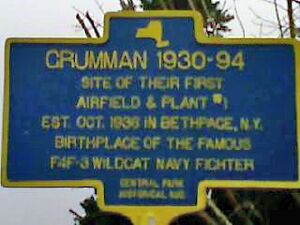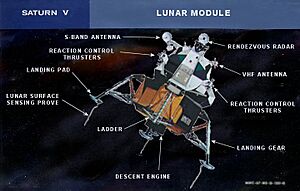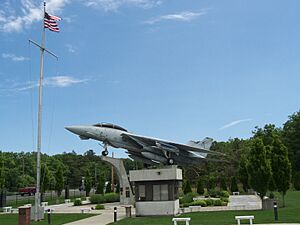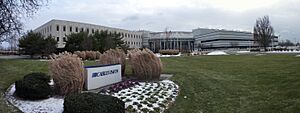Grumman facts for kids
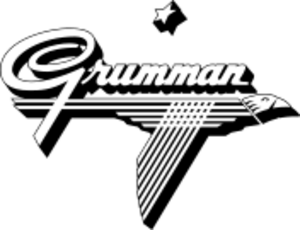 |
|
| Industry | Aircraft; aircraft parts and equipment; data processing and preparation; search and navigation equipment; truck and bus bodies; electrical equipment and supplies |
|---|---|
| Fate | Merged with Northrop |
| Successor | Northrop Grumman |
| Founded | December 6, 1929 |
| Founders |
|
| Defunct | April 4, 1994 |
| Headquarters |
,
U.S.
|
|
Key people
|
|
| Products |
|
|
Number of employees
|
23,000 (1986) |
| Subsidiaries |
|
The Grumman Corporation was a famous American company. It built many military and civilian airplanes during the 20th century. The company started on December 6, 1929, by Leroy Grumman and his partners. In 1994, it joined with another company called Northrop Corporation to become Northrop Grumman.
Contents
Building Amazing Aircraft: Grumman's History
Leroy Grumman worked for another airplane company before starting his own. In 1929, that company moved, so Leroy and three friends decided to create their own business. These friends were Edmund Ward Poor, William Schwendler, and Jake Swirbul. They set up their new company in an old factory in Baldwin, New York, on Long Island.
The company officially opened on January 2, 1930. To earn money, they first welded aluminum tubes for truck frames. But their main goal was to build airplanes for the U.S. Navy. Grumman designed special floats with wheels that could be pulled up. This invention helped them get into the aviation market.
Grumman's first airplane for the Navy was the Grumman FF-1. It was a biplane (a plane with two main wings) with retractable landing gear. This means the wheels could fold up into the plane after takeoff. Many other successful plane designs followed.
During World War II, Grumman became very well known. They built powerful Navy fighter aircraft nicknamed "Cats." These included the F4F Wildcat and F6F Hellcat. They also built the Grumman TBF Avenger, a plane that dropped torpedoes. Grumman was one of the top companies making war supplies in the U.S.
After the war, Grumman started making jet aircraft. Their first jet was the F9F Panther. Later, they built famous planes like the A-6 Intruder and the F-14 Tomcat. You might have seen Grumman planes in movies like Top Gun! Some of their planes, like the Hawkeye, are still used by the U.S. Navy today.
Grumman played a huge role in space exploration too. They were the main company that built the Apollo Lunar Module. This was the spacecraft that landed humans on the Moon! They got the contract in 1962 and built 13 lunar modules. Six of them successfully landed on the Moon. One even saved the lives of astronauts on Apollo 13 after their main spacecraft was damaged.
As the Apollo program ended, Grumman tried to get the contract to build the Space Shuttle. However, they lost to another company.
In 1969, the company changed its name to Grumman Aerospace Corporation. They also started making other things. They built the Grumman LLV (Long Life Vehicle), which is a light mail truck. The United States Postal Service still uses many of these trucks today!
Grumman also made Gulfstream business jets. These planes were used by many companies, private owners, and even government groups like NASA.
Grumman's Home on Long Island
For many years, Grumman was the biggest employer on Long Island, New York. Their products were known for being very strong and reliable. Because of this, people often called the company the "Grumman Iron Works."
As Grumman grew, it moved to different towns on Long Island. Its main facility was in Bethpage, New York. They did testing and final assembly at a large area in Calverton, New York. At its busiest in 1986, Grumman had 23,000 employees on Long Island.
When the Cold War ended in the early 1990s, the U.S. government spent less money on defense. This led to many aerospace companies joining together. In 1994, Northrop bought Grumman for $2.1 billion. This created the new company, Northrop Grumman.
After the merger, most of Grumman's facilities on Long Island closed. The Bethpage plant became a mix of homes and offices. The old headquarters is now used by Cablevision. The Calverton plant became a business park. Some of the old airplane hangars are now Grumman Studios, where movies and TV shows are made. There's even a Grumman Memorial Park where you can see some of their famous planes.
Grumman's Amazing Products
Grumman built many different types of aircraft and other interesting things.
Aircraft Grumman Built
Here are some of the aircraft Grumman designed and built:
| Model name | First flight | Number built | Type |
|---|---|---|---|
| Grumman FF | 1931 | 116 | Single engine Navy fighter plane |
| Grumman JF Duck | 1933 | 48 | Single engine floatplane for observation |
| Grumman F2F | 1933 | 55 | Single engine Navy fighter plane |
| Grumman F3F | 1935 | 147 | Single engine Navy fighter plane |
| Grumman XSBF | 1936 | 1 | Prototype single engine dive bomber |
| Grumman J2F Duck | 1936 | 254 | Single engine floatplane for observation |
| Grumman G-21 Goose | 1937 | 345 | Twin engine flying boat |
| Grumman F4F Wildcat | 1937 | 2,605 | Single engine Navy fighter plane |
| Grumman G-44 Widgeon | 1940 | 276 | Twin engine flying boat |
| Grumman XF5F Skyrocket | 1940 | 1 | Prototype twin engine Navy fighter |
| Grumman XP-50 | 1941 | 1 | Prototype twin engine fighter |
| Grumman TBF Avenger | 1941 | 2,290 | Single engine torpedo bomber |
| Grumman F6F Hellcat | 1942 | 12,275 | Single engine Navy fighter plane |
| Grumman F7F Tigercat | 1943 | 364 | Twin engine Navy fighter plane |
| Grumman G-63 Kitten I | 1944 | 1 | Prototype single engine airplane |
| Grumman G-72 Kitten II | 1944 | 1 | Prototype single engine airplane |
| Grumman F8F Bearcat | 1944 | 1,265 | Single engine Navy fighter plane |
| Grumman G-65 Tadpole | 1944 | 1 | Prototype single engine flying boat |
| Grumman AF Guardian | 1945 | 389 | Single engine anti-submarine airplane |
| Grumman G-73 Mallard | 1946 | 59 | Twin engine flying boat |
| Grumman HU-16 Albatross | 1947 | 466 | Twin engine flying boat |
| Grumman F9F Panther | 1947 | 1,382 | Single jet engine Navy fighter |
| Grumman F9F-6 Cougar | 1951 | 1,988 | Single jet engine Navy fighter |
| Grumman XF10F Jaguar | 1952 | 1 | Prototype single jet engine Navy fighter |
| Grumman S-2 Tracker | 1952 | 1,184 or 1,185 | Twin engine anti-submarine airplane |
| Grumman F11F Tiger | 1954 | 200 | Single jet engine Navy fighter |
| Grumman C-1 Trader | 1955 | 87 | Twin engine cargo airplane |
| Grumman F11F-1F Super Tiger | 1956 | 1 | Prototype single jet engine Navy fighter |
| Grumman E-1 Tracer | 1956 | 88 | Twin engine airborne early warning plane |
| Grumman G-164 Ag Cat | 1957 | 402 | Single engine agricultural airplane |
| Grumman G-159 Gulfstream I | 1958 | 200 | Twin turboprop business airplane |
| Grumman OV-1 Mohawk | 1959 | 380 | Twin turboprop observation airplane |
| Grumman A-6 Intruder | 1960 | 693 | Twin jet engine attack airplane |
| Grumman E-2 Hawkeye | 1960 | 122 | Twin turboprop airborne early warning plane |
| Grumman C-2 Greyhound | 1964 | 56 | Twin turboprop cargo airplane |
| General Dynamics–Grumman F-111B | 1965 | 7 | Prototype twin jet engine Navy fighter |
| Grumman G-1159 Gulfstream II | 1966 | 256 | Twin jet engine business airplane |
| Grumman EA-6B Prowler | 1968 | 170 | Twin jet engine electronic warfare plane |
| Grumman F-14 Tomcat | 1970 | 712 | Twin jet engine Navy fighter |
| Grumman American GA-7 Cougar | 1974 | ~1 | Twin engine civilian airplane |
| General Dynamics–Grumman EF-111A Raven | 1977 | 42 | Twin jet engine electronic warfare plane |
| Grumman X-29 | 1984 | 2 | Experimental single jet engine airplane |
| Grumman XJL | N/A | 0 | Single engine floatplane for observation |
| Grumman American AA-1 | 1963 | 1820 | Single engine civilian airplane |
| Grumman American AA-5 | 1970 | 3282 | Single engine civilian airplane |
Spacecraft and Other Cool Products
- Spacecraft
- Apollo Lunar Module: This was the spacecraft that landed astronauts on the Moon.
- Other Products
- Fire Engines: Grumman made fire engines called Firecat and Aerialcat.
- Canoes: Grumman started making aluminum canoes during World War II. They were known for being very strong and light.
- Grumman-Flxible 870 buses: Grumman also built city buses for a few years.
- Grumman LLV postal vehicle: This is the mail truck widely used by the United States Postal Service and Canada Post.
- Ben Franklin (PX-15): This was a special science submarine.
Images for kids
-
An F-14A Tomcat jet.
-
An A-6E Intruder flying over Spain.
-
A Grumman Olson UPS truck.
-
A Grumman Kurbmaster Hostess Delivery truck.


